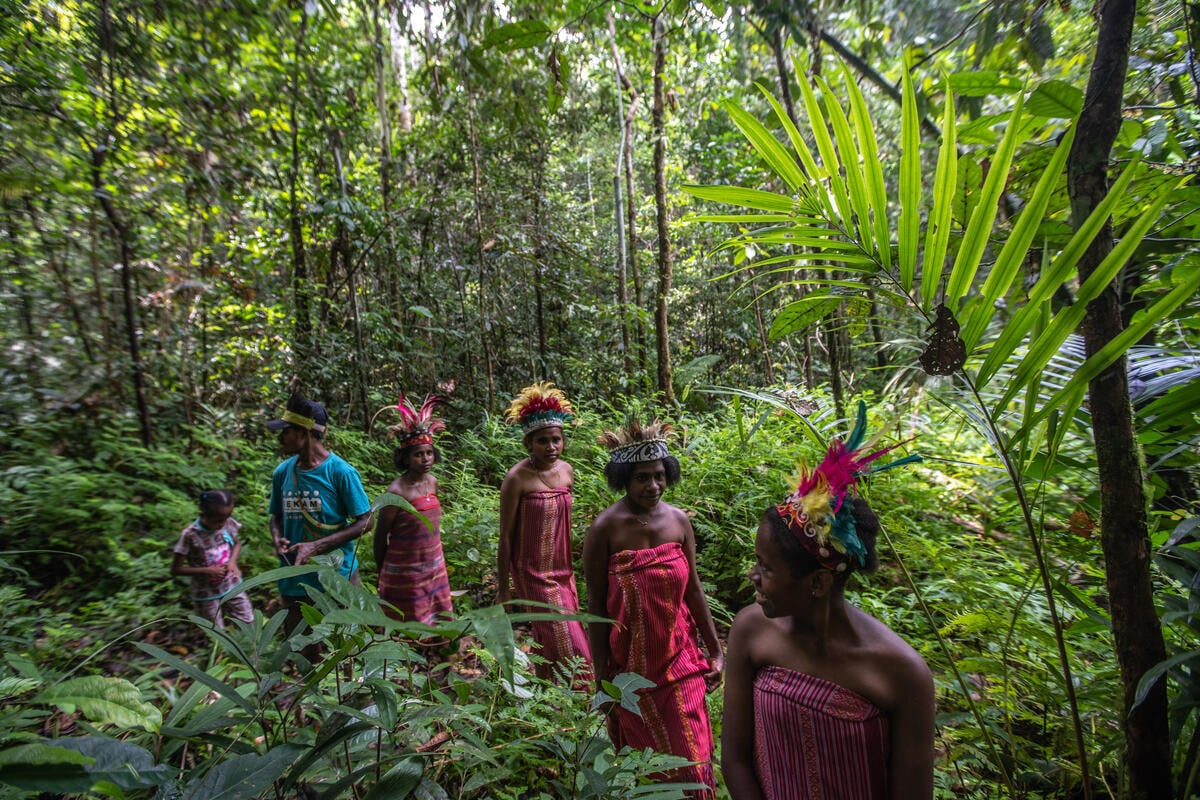



Fireside chat with Kate Wharton,
CrossBoundary Managing Director & Head of Natural Capital
- Kate Wharton, CrossBoundary Managing Director & Head of Natural Capital
Back to main blog pageELJ: How did your time as COO at Hala Systems influence your approach to climate and nature finance?
KW: This is a question that I don’t think I’ve ever been asked before! It’s an unusual connection, as I came into nature finance through a different path. Many people in this industry have a background in environmental science or conservation, but my career started in international development and the humanitarian space.
ELJ: I see. So how did your work in international development shape your approach?
KW: For me, the story starts with people and the impact on them. At Hala Systems, we worked on civilian protection from airstrikes in Syria. This focus on empowering people was central. When I transitioned to CrossBoundary, I spent the first few years opening and managing our office in Iraq, where the focus was on recovery post-ISIS and supporting entrepreneurs to create jobs and diversify the economy.

ELJ: What prompted you to pivot toward climate and nature finance while in Iraq?
KW: It was during the pandemic in Erbil that I started to pivot towards climate, and specifically natural climate solutions. When you look at the data, conflict-affected areas aren’t progressing on the SDGs, and I saw the environmental crisis first hand in Iraq — sandstorms, record-breaking temperatures, and for many people, only a few hours of grid electricity a day during the summer months. It became clear that addressing climate change was key to having any long-term impact in fragile and conflict-affected states. Nature, in particular, is an underfunded area in climate finance, with less than 3% of climate finance going towards it. And we need to mobilise capital at scale.
ELJ: It sounds like your personal experiences played a role as well.
KW: Absolutely. I grew up outside of Cincinnati, Ohio on five acres of land in the woods, and my dad now works for a state park in the Florida panhandle, so nature has always been an important presence in my life. This intersection of personal and professional experiences made me realise the importance of focusing on nature within the climate space.
ELJ: What are your primary responsibilities as Managing Director, Head of Natural Capital at CrossBoundary?
KW: I lead our Natural Capital practice, which is about a dozen people now! It’s one of two sector-focused teams, along with Power & Infrastructure, as most of our teams are organised regionally.

ELJ: That sounds like a significant growth area. Can you explain how CrossBoundary is structured, and how your natural capital team fits into the broader mission?
KW: Sure, maybe I can take a step back to explain a bit about CrossBoundary to put things in context. CrossBoundary started in 2011 with a simple mission: to unlock private capital in emerging and frontier markets. We’re organised around two ways to support capital absorption, and Natural Capital spans both — (1) our investment advisory practice, working on both buy-side and sell-side transactions, and (2) investment management, where we have designed and manage several investment vehicles which target specific sectors and geographies where we saw gaps in the market.
ELJ: You mentioned the challenge of raising capital in emerging markets. Can you talk more about the barriers you see in climate finance and natural capital investment?
KW: Absolutely. There’s a lot of money out there, especially for climate projects. Not all have mandates in emerging markets, but many do. What they often lack, however, is on-the-ground teams in those countries. This is where we come in — being the local experts who can help originate, diligence, and structure deals in underserved markets. We build our teams accordingly, with around 270 colleagues globally across 25 offices. Most (around 80%) are in emerging markets. These local teams know the investment climate, markets, and key players. We work to overcome transaction-level barriers that prevent good deals from happening.
ELJ: What are some specific barriers that keep transactions from going through?
KW: There are a couple of key issues. The first is high transaction costs, especially for nature and climate deals. If you’re an investor looking at a new geography or sector for the first time, that’s an added cost. You’re much more likely to invest in places where you’ve done deals before. The second issue is information asymmetry, which is different from an information gap. As an investor, how do you know if you’re seeing the best deals? As an entrepreneur or manager who may be raising from new capital sources, how do you know you’re getting fair terms? There’s often a lack of trust on both sides, and we help solve that ‘trust gap’.
ELJ: How does this apply specifically to your work in natural capital?
KW: On the advisory side, we support companies and projects raising capital, many of which rely on environmental markets including the sale of carbon credits as a revenue stream, and investors looking to deploy capital into these markets. On the investment management side, I lead the Fund for Nature, which focuses on early-stage nature-based carbon projects in emerging markets. Our focus is on deploying capital that will directly restore and protect critical ecosystems.
ELJ: Could you elaborate on the objectives and expected impact of the Fund for Nature (FFN) that you are launching?
KW: The Fund for Nature is focused on catalysing nature-based carbon projects in emerging markets, with a focus on Sub-Saharan Africa and the Amazon. We know that the destruction of nature is a market failure resulting from not pricing nature’s positive externalities. Carbon markets change this by putting a price on carbon sequestration and unlocking a results-based, investable business model for nature-based projects with climate impact. As investors, we view nature as infrastructure which needs infrastructure-like financing to scale. The Fund for Nature is designed based on lessons we’ve learned and gaps we’ve seen while advising nature-based carbon projects.
ELJ: What specific gaps have you identified that the Fund for Nature aims to fill in the nature-based carbon market?
KW: One of the key gaps we’ve noticed is in the project development and pilot phase of a project. There’s often a gap between initial funding either from a grant or the developer’s own balance sheet, and the larger carbon funds that typically come in later, once the project has been de-risked and is fully “shovel-ready”.

ELJ: Could you explain why early-stage funding is so critical for these projects?
KW: Many projects don’t need $30 million yet; they need $2-5 million to get to the point where they are ready to raise larger amounts of capital required to implement the project at scale. At this stage, they can secure better valuations and have a clearer understanding of the project’s economics, operations, and partnerships.
ELJ: What makes the project development stage particularly important from an impact perspective?
KW: It’s crucial because this is when key decisions are being made: where exactly the project will be located, what types of trees will be planted, strategies for long-term conservation, and community participation and benefit-sharing. Ensuring that this stage is done well is vital for achieving the high level of quality we expect.
ELJ: How does CrossBoundary’s local expertise contribute to this process?
KW: Our “boots on the ground” approach is critical. We believe our team is uniquely positioned to conduct due diligence and identify high-potential early-stage projects because we know these markets well and often have a long-term presence. Local knowledge is a significant advantage when it comes to finding and supporting promising projects, and troubleshooting during implementation.
ELJ: I can see that’s an advantage — if you do know these geographies really well. My next question is about what challenges you encounter when advising on nature-based carbon projects in emerging and frontier markets, and how do you address them?
KW: Some of these challenges are consistent with other projects we see in emerging markets. I mentioned transaction costs and information asymmetry earlier, and these issues tend to be even more amplified for nature-based projects because of the number of stakeholders involved, the complexity, and the size of investments.
ELJ: Could you highlight any unique challenges specifically tied to nature-based projects?
KW: Another challenge we think about a lot is the concept of the “pioneer penalty.” In emerging markets, unlike in developed markets, being a first mover often carries disadvantages. There are significant costs that the first mover must internalise, even though everyone who follows benefits from their efforts. For example, in nature-based projects, this can be educating investors and buyers on the basics of carbon markets. Project developers spend a great deal of time just explaining "Carbon Markets 101"!
ELJ: That sounds like an extensive and complex process. What role do governments play in these projects, especially when it comes to policy environments?
KW: The policy environment is often a challenge, especially as governments work through the implementation of Article 6 and figure out how domestic policies will align with broader UN commitments. When it comes to carbon, governments are determining how to ensure this new economic opportunity benefits their citizens. Questions arise about how carbon projects should be taxed, how to structure benefit-sharing, and how to regulate the export of carbon credits. Developers and investors often have to closely engage in these live policy conversations, which adds to project costs.
ELJ: Beyond policy, what about the logistical challenges, such as local supply chains and talent development?
KW: Building local supply chains can be another challenge. For example, with a reforestation project, nurseries to supply the tree saplings may not exist, so developers may need to create their own integrated supply chains out of necessity - the same pattern of vertical integration that we frequently see in other pioneering companies in emerging markets. On the talent side, the first carbon project in a region will need to do a lot of hiring and training of local staff who are new to carbon markets. That human resources piece is another part of the first-mover challenge.

ELJ: It sounds like first movers face a lot of hurdles. How does CrossBoundary support these early-stage projects?
KW: One way that we support early-stage projects is in partnership with donors such as USAID, who want to see investments in these countries not only for environmental impacts but also for job creation, stabilisation, food security, and other development objectives. By funding investment facilitation, donors enable us to address first-mover challenges and bring in new investment, even in more challenging markets. And unlocking private investment can be great leverage for donor funding!
ELJ: Can you give an example of a project that CrossBoundary is supporting in this space?
KW: A good example is our investment in a biochar company in Kenya, called Bio-Logical. Bio-Logical sells carbon credits and produces low-cost, biochar-enhanced fertiliser for local farmers. Bio-Logical is importing customised machinery, growing its team of local engineers, setting up relationships with feedstock providers, testing its fertiliser product to compare yield increases, and demonstrating the results to farmers. They are not only supporting companies like Microsoft to meet their climate mitigation commitments, but also supporting smallholder farmers in East Africa to increase crop yields in a climate that is growing hotter and drier.
ELJ: Carbon markets have faced some criticism regarding their potential for greenwashing. How do you address this concern in your work?
KW: It's easy to be a critic in this space, and I understand why there are different perspectives. From my vantage point, climate change and the loss of nature are the result of a massive market failure based on unpriced positive and negative externalities. Regulation is necessary, and voluntary action also plays a crucial role.
ELJ: How do you see the role of voluntary action, particularly in carbon markets?
KW: Carbon markets help unlock new business models for nature which is important because there is simply not enough philanthropic or public funding available to restore and protect nature at the scale required. We are in a critical decade for addressing climate change, and we need to be pragmatic —nature is currently the only scalable carbon removal solution. Waiting for regulation, or waiting for new technologies for carbon removal, will mean delaying action and in doing so increasing the costs of action including adaptation. And of course the greatest effects of delay will be felt by vulnerable communities for whom climate change is already here. Voluntary action is also important for testing new solutions and improving carbon methodologies, and for corporates to get in place the systems required to measure their carbon footprint, develop holistic net zero strategies, and build strong climate teams to deliver on these strategies.
ELJ: What makes carbon markets particularly effective in this context?
KW: One of the strengths of carbon markets is that they’re results-based finance. This means we’re not just paying to plant trees; we’re paying to keep forests standing and healthy.
ELJ: What do you say to critics who claim companies use carbon credits as a cover for not reducing their emissions?
KW: There’s often an assumption that companies buying carbon credits are only doing that and not investing in emissions reductions. That’s simply not the case. Recent research shows that companies participating in the voluntary carbon market also tend to have more aggressive science-based targets and invest more in emissions reductions compared to those that don’t participate.
ELJ: And what about sectors where emissions are harder to reduce?
KW: There are also hard-to-abate sectors where emissions will take time to address. We need to push for reductions as quickly as possible, but the alternative – doing nothing to address residual emissions – is simply unacceptable. So, in my view, carbon markets are a necessary part of the solution as we transition to a net zero economy.
ELJ: There’s another important criticism of carbon markets, which focuses on their effectiveness in equitably engaging local communities. What measures can ensure the credibility and positive impact of carbon markets?
KW: Community engagement is close to my heart, and it’s something we spend a lot of time thinking about. A concern I have is that well-meaning critiques of community engagement will simply lead to fewer projects on lands with Indigenous Peoples and Local Communities (IPLCs) – in effect, excluding these communities from climate finance altogether even if they wish to participate. We’re already seeing investors favouring private lands without people, and in my opinion that would be a huge failure.

ELJ: What are some key steps that can ensure projects with IPLCs are done correctly?
KW: First, there is a growing body of tools and resources that developers and investors can draw from to ensure they are following best practices when partnering with IPLCs. This includes aligning with IFC Performance Standards. Second, one reason we focus on funding the development stage of projects is because proper community engagement can be time-intensive and costly. It must be well-funded, and so it’s crucial that investors and buyers of carbon credits understand that they need to cover the costs of IPLC engagement.
ELJ: How does this impact project timelines and costs?
KW: Doing free, prior, and informed consent (FPIC) properly cannot be rushed, but doing it right helps ensure longevity of the project. We need to think about this carefully as investors and make sure that project costs properly account for robust community engagement and participation throughout the project, and also that carbon credit buyers understand the true cost of developing high-quality projects.
ELJ: In your experience, what are the most effective mechanisms for integrating local communities into nature-based carbon projects to ensure both environmental and social benefits?
KW: We think about this from a few angles. One aspect is the conversation around benefit sharing with local communities, which often focuses on the numbers. But we think about it in three stages: (1) the process of arriving at the benefit-sharing agreement; (2) the actual allocation of revenue and non-monetary benefits; and (3) how the agreement is implemented in practice.
ELJ: What key principles guide you in structuring benefit-sharing agreements?
KW: First, we view IPLCs as project partners, not beneficiaries. I dislike the term “benefit-sharing” because the conversation should really be around what communities are contributing, especially when a behaviour change is crucial to achieving climate outcomes. Second, it’s communities who are often taking the greatest risk, and we need to acknowledge and compensate them for that risk. We often discuss risk-adjusted returns for investors but overlook the risk faced by the communities themselves.
ELJ: How do you ensure that communities receive fair compensation?
KW: Communities should see cash flowing from the very beginning of the project, and they need predictable compensation regardless of project performance. At the same time, if the project performs well, they should share in the upside. These are structures we’re starting to see more consistently in projects.
ELJ: What role does decision-making play in IPLC engagement?
KW: We often place unfair expectations around decision-making, assuming communities can make quick decisions on complex projects. Individuals need time to consider, reflect, and educate themselves on the benefits and drawbacks of participation in a carbon project. Additionally, we must consider the time horizons of different actors. For a smallholder farmer, immediate needs may supersede long-term benefits, creating a power imbalance in the negotiations. It’s essential to recognise and respond to these dynamics, for example by ensuring access to third-party legal counsel or neutral investment advisors.

ELJ: : What are the most promising opportunities you see in natural capital investment?
KW: A few things excite me. First, long-term offtake agreements are especially valuable for native species restoration projects, which require upfront capital and may take years before credits are issued. The Symbiosis Coalition is an exciting development, providing advanced market commitments for nature-based carbon removals. Second, as we gather more data on the risk-return profiles of these projects, we can unlock new types of capital. Finally, the professionalisation of the sector is promising. We are seeing deepening expertise within the sector, and also growing interest from smart people from a wide range of backgrounds who want to work on nature and climate. This gives me hope because there is so much power in each of us choosing where to put our own limited time and resources.